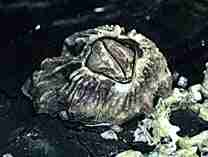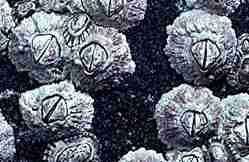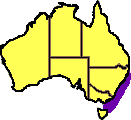|
|
Rose-coloured Barnacle, Tesseropora rosea
Form:
 A
tall, conical barnacle, normally white
in colour, but when eroded has a pink tinge. There are four main wall
plates, but the opening (orifice) is five-sided (pentagonal) in shape.
Inside the plates is porous, broken by radial walls.
A
tall, conical barnacle, normally white
in colour, but when eroded has a pink tinge. There are four main wall
plates, but the opening (orifice) is five-sided (pentagonal) in shape.
Inside the plates is porous, broken by radial walls.
 Colour:
Colour:
Young rose-coloured barnacles are grey to white in colour, with a pinkish colour at the shell plate tips. Older individuals may be more eroded, showing more pink colour.
Phylum: |
Arthropoda |
Author: |
Krauss, 1848 |
Family: |
Tetraclitidae |
Size: |
20 mm diameter, 12 mm height |
Distribution:
 Occurs
from New South Wales, to north-eastern Victoria. Occasionally in north-eastern
Tasmania. Restricted to south-eastern Australia.
Occurs
from New South Wales, to north-eastern Victoria. Occasionally in north-eastern
Tasmania. Restricted to south-eastern Australia.
Habitat:
Occurs at mid to high-tide levels on exposed coasts where the wave action is moderate to strong. Often found on the outer side of the rock face fully exposed to the raging surf. It is never found in estuaries, or on wood. It may be found with the Surf Barnacle, Catomerus polymerus.
Biology:
When the waves are swashing across it, the Rose-coloured Barnacle spreads its feeding arms (cirri) like a net as the wave rushes back from the shore, trapping small zooplankton for food. This barnacle often occurs in very exposed situations, and can resist being desiccated by the sun for long periods of time, sometimes weeks.
References:
Bennett, I. (1987) W.J. Dakin's classic study: Australian Seashores. p.246, Angus & Robertson, Sydney.
Davey, K. (1998) A Photographic Guide to Seashore Life of Australia. p.42, New Holland, Sydney.
Edgar, G.J. (1997) Australian Marine Life: the plants and animals of temperate waters. p.174, Reed Books, Kew.
Marine Research Group of Victoria (1984) Coastal Invertebrates of Victoria: an atlas of selected species. p.106, Museum of Victoria, Melbourne.
Underwood, A.J. & Chapman, M.G. (1993) Seashores: a beachcomber's guide. p.36, New South Wales University Press, Sydney.
Surf
Barnacle
Six-plated Barnacle
Honeycomb Barnacle
Rose-coloured Barnacle
Rosette Barnacle
Giant Rock Barnacle
Home
Page
Taxonomy
Biogeography
Rocky Shores
Tidal Levels
Intertidal Zonation
Environmental Factors
Biological
Factors
Feeding Relationships
Activities
Glossary
References
 Life
on Australian Seashores
Life
on Australian Seashores
by Keith Davey (C) 2000
Learning Consultant
- Media
The University of Newcastle
email at australian_seashores@hotmail.com
Scientific Consultant: Phil
Colman
site created 01.01.98 : updated 01.04.2000
